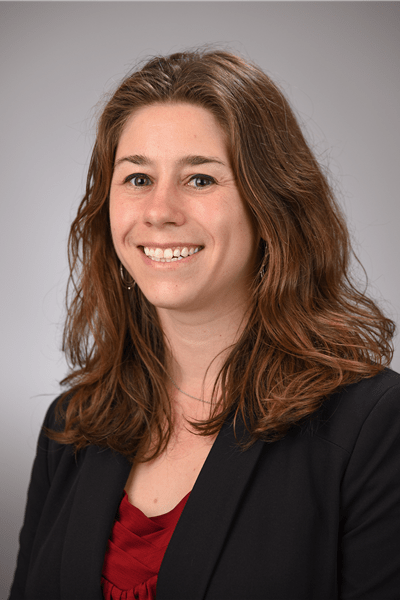
Jessica Maiers, PhD
Assistant Professor of Medicine
Adjunct Assistant Professor of Anatomy, Cell Biology, & Physiology
Key Publications
Buchl SC; Hanquier Z; Haak AJ; Thomason YM; Huebert RC; Shah VH; and Maiers JL. TNIK is a critical regulator of procollagen I trafficking and fibrogenesis in mice. Hepatology Communications. 2021 Oct 22; PMID: 34677004
Xue F, Liu J, Buchl SC, Sun L, Shah VH, Malhi H, Maiers JL. Coordinated Signaling of Activating Transcription Factor 6α and Inositol Requiring Enzyme 1α Regulates Hepatic Stellate Cell-Mediated Fibrogenesis in Mice. Am J Physiol Gastrointest Liver Physiol. 2021 Mar 17. PMID: 33728997.
Liu, Z; Li, C; Kang, N; Malhi, H; Shah, VH; Maiers, JL. TGFβ crosstalk with the Unfolded Protein Response is critical for Hepatic Stellate Cell activation. Journal of Biological Chemistry. 2019 Mar 1; 294(9):3137-3151. PMID: 30610118
Maiers, JL; Kostallari, E; Mushraf, M; Li, H; Yu, H; Hubert, RC; Cao, S; Malhi, H; Shah, VH. TANGO1 promotes fibrogenesis through dual mechanisms of collagen I secretion and ER stress. Hepatology. 2017 March. PMID: 28039913.
| Year | Degree | Institution |
|---|---|---|
| 2013 | PhD | University of Iowa |
| 2008 | BA | Wartburg College |
My research program focuses on understanding the molecular mechanisms of liver fibrosis. The primary fibrogenic cells in the liver are Hepatic Stellate Cells (HSCs). Chronic liver injury promotes differentiation of quiescent HSCs into myofibroblasts which drive fibrogenesis through producing and secreting extracellular matrix (ECM) proteins including procollagen I. ECM secretion creates two problems for HSCs: 1) procollagen I is too large to traffic through the secretory pathway using canonical mechanisms, and 2) increased ECM production activates stress responses which impact cellular homeostasis. Fibrotic HSCs exhibit persistent ECM production and secretion without succumbing to apoptosis; however, the mechanisms regulating this are unclear. We identified the ER protein TANGO1 as a critical moderator of procollagen I ER export in HSCs in vitro and moderator of fibrogenesis in vivo. Loss of TANGO1 in HSCs led to procollagen I retention, HSC apoptosis, and reduced fibrogenesis; suggesting that TANGO1 and ECM trafficking machinery could serve as therapeutic targets. We also interrogated how the unfolded protein response (UPR) and fibrogenesis in HSCs. UPR signaling promotes protein secretion, but also impacts cellular homeostasis. ECM production promotes UPR signaling through ATF6α andIRE1α. Interestingly, both ATF6α and IRE1α signaling are critical for fibrogenesis in vitro and in vivo, though the crosstalk between these pathways and how they influence fibrogenesis is unclear. Building upon this work my lab focuses on two major goals.
1. Understand the mechanisms of procollagen I trafficking: We developed an immunofluorescence-based screening platform. HSCs were transfected with an siRNA library targeting genes involved in membrane trafficking. This screening platform identified several proteins whose knockdown led to intracellular procollagen I retention. These proteins have diverse functions and roles in membrane trafficking, including endocytosis, suggesting that procollagen I export involves coordination of multiple processes. We have validated these targets and are working to discern their role/mechanism of action in procollagen I trafficking. This screen not only moved forward our work studying ECM trafficking, but also provides a platform to identify compounds that disrupt procollagen I trafficking and fibrogenesis.
2. Elucidating how activated HSCs maintain cellular despite persistent secretory stress: The mechanisms through which HSCs exhibit persistent ECM secretion without succumbing to stress-induced apoptosis are unknown. We propose that understanding how HSCs regulate the UPR to avoid apoptosis would provide unique insight into how we could target activated HSCs for apoptosis. To address this, we are using in vitro and in vivo models to interrogate UPR signaling influence fibrogenesis, as well as HSC homeostasis and survival.
Hanquier Z; Thomason Y; Maiers JL; 2022 May
Duwaerts CC; Maiers JL; Frontiers in molecular biosciences 2022 Jan 31
Yang Z; Han S; Zhang T; Kusumanchi P; Huda N; Tyler K; Chandler K; Skill NJ; Tu W; Shan M; Jiang Y; Maiers JL; Perez K; Ma J; Liangpunsakul S; Hepatology communications 2022 Feb 8
Buchl SC; Hanquier Z; Haak AJ; Thomason YM; Huebert RC; Shah VH; Maiers JL; Hepatology communications 2021 Oct 22
